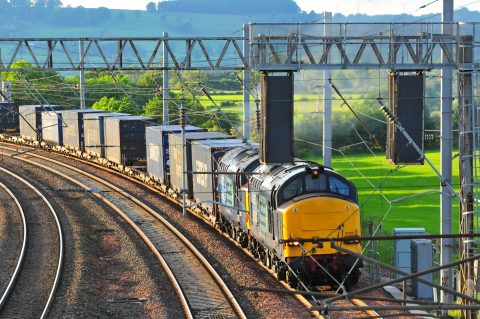
Changes to UK track access charges system ‘could harm rail’s competitiveness’
Potential changes to how track access charges in the UK are calculated could present a threat to rail’s competitiveness. Rail economics expert Professor Chris Nash will deliver this stark warning when he speaks at the Track Access Charges (TAC) Summit in Amsterdam in April.
The method by which access charges are calculated and applied is of critical importance both to infrastructure managers, who depend on them as a source of income, and to train operators, for whom they can be a significant cost. Charges paid by operators to Network Rail, Britain’s IM, are based on whether they are a franchise holder, a freight operator or use the network on an ‘open access basis’. Open access passenger services only pay marginal cost, freight operators pay marginal cost plus – for some commodities – a mark-up, and franchised passenger operators pay marginal cost plus a fixed charge.
Experience
Professor Nash, who has extensive experience of research in this area, including advising the British rail regulator and the European Commission, will be focusing at the summit on the role of ‘mark-ups’ in how TACs are levied in the UK. He says that for some years, the UK has applied mark-ups inthe freight sector which are capped at ‘freight avoidable cost’, and based on an ability-to-pay test. Freight avoidable costs essentially are costs that Network Rail could avoid if freight services did not use its infrastructure, such as freight only lines and passing loops only needed for freight traffic.
“There are current proposals in Britain to change the way track access charges are levied, and move towards a mark-up on variable costs for passenger as well as freight services,” said Prof Nash. “I believe the thinking is partly that we have seen a bit of an expansion of open access passenger operation, and there is a suggestion that this may significantly expand. Currently in the passenger sector only franchisees pay more than marginal costs, so charging a mark-up for both franchisees and open access operators would be a fairer regime.”
The Office of Rail and Road in the UK, which regulates the rail industry, is in the midst of a review of TACs as part of the long-term plans for when it sets Network Rail’s charging structure for the next control period, known as CP6, from 2019 to 2014.
‘Potentially dangerous’
“I think there is also a feeling that facing operators with more of the costs will give them more of an incentive to work with Network Rail to try to get them down, so we may move to much higher variable charges,” said Prof Nash. “Currently they are relatively low, but I believe that a big increase is potentially dangerous and could harm the position of rail in the markets where it is applied. That could impact on freight, although there would still be an ability to pay test, and it’s really how that test is applied that would determine whether freight faced much higher charges or not.
“When mark-ups for freight were first introduced, they were only permitted for commodities where they had very little impact on traffic levels. But another interpretation of ability to pay is that the sector can pay the charges provided at least some traffic remains. “
Regarding avoidable costs, Prof Nash explained: “ Since 1974, the British government has taken the view that the railways in Britain are mainly there for passenger train traffic. Freight should be allowed to use it, so long as freight pays its avoidable costs, and that is why it wanted these mark-ups on freight traffic to recover the avoidable costs. But a new system of costing is under discussion which would also allocate freight a share of the joint costs, and thus potentially open the way to higher charges. “
‘Poor relation’
It’s a development which reflects the often-held perception that, for all the talk about how rail freight is better for the environment, it remains the ‘poor relation’ of the railways, with track access charges one of the central elements to the debate. “I think there is a big issue that many countries – and that includes Britain – tend to look at track access charges for rail as a totally separate issue from the charges for heavy goods vehicles to use the road system,” said Prof Nash. “So however efficient we make the charges for rail if the charges for roads are inadequate, then that will continue to distort the market.”
He also highlighted the much-discussed example – at least within the rail industry – of rail’s access to Felixstowe docks, on the east coast of England: “A lot of containers go to Felixstowe by road because there is not enough track capacity for both the lightly-loaded passenger trains and the container trains, and so it’s the passenger trains that get the line capacity.” Not surprisingly then he’s a proponent of a multi-million pound scheme, announced last year, to dual part of the Felixstowe-Ipswich branch line to increase its rail freight capacity. The government says the scheme should be completed by the end of 2019: “Here we have investment going on now to enable freight to expand, so it is not all gloomy,” he said.
A research professor at the Institute for Transport Studies at the University of Leeds, as well as holding positions at both Masaryk University in the Czech Republic and the Centre on Regulation in Europe in Brussels, Prof Nash will be speaking on day two of the Track Access Charges Summit, which takes place from April 4-5, at the Bimhuis in Amsterdam.
Market segments
His presentation will examine the proposed method of cost allocation, the proposed identification of market segments and the likely impact of any proposed changes.
“The UK system of charges is currently probably one of the most efficient in Europe,” he said. “We have a direct charge which varies with the type of rolling stock, quite detailed variations according to the estimated damage to the track, and we have a capacity charge which is based on the extra congestion and unreliability caused when routes get overloaded. We currently have a system where the variable charges are designed to give the right incentives in terms of level of service and type of rolling stock, and the financial needs are made up by non-discriminatory fixed charges on franchisees. The proposed changes would be introduced in the coming control period for 2019 onwards, so it is potentially not far off.”
Prof Nash added that most of the rest of Europe ‘has nothing like’ the degree of differentiation according to rolling stock Britain has. “There is a big variation across Europe, from country to country, not just in terms of level but also the structures,” he said. “For instance, in France and Germany, basically the charges are ‘per train kilometre’, with only a limited amount of variation according to the type of trains. So, in terms of incentives for track-friendly vehicles, those are largely missing in those countries. Also, many countries have a big mark-up on variable charges for some sorts of traffic, so in terms of incentives I would say currently Britain has a rather more efficient system.”
Brexit impact
He also sees the looming reality of Brexit as not likely to have much of an impact on TACs in the UK: “I don’t see much sign under our current government that they would wish to depart much from European rail policy, whatever happens regarding Brexit. The Labour Party has declared itself in favour of renationalising the industry, so they could wish to depart from European policy on the extent to which competition is permitted or required, but in general I don’t expect it will have a big impact on track access charges in the UK.
“Obviously it all depends on the deal, so for example both Norway and Switzerland, under the deals they have, still follow some parts of the European legislation on rail, including the track access charges, so it is possible there would be an agreement whereby we would be required to still follow EU legislation on that.”
Prof Nash is also leading the preparation of a report on TACs for the Centre on Regulation in Europe, which is in Brussels. Due to be presented in May or June, the report will be a study on the current position in several European countries, from which he hopes to draw up some valuable examples of best practice.
Incentive effects
“I think a key message, but also a general one at that, is that it is very important for everyone involved to think about the incentive effects that track access charges have, the impact they have on rail’s ability to compete with other modes, and the efficient provision of rail services,” he added.
Do you want to attend the Track Access Charges Summit? Book your place online here.






